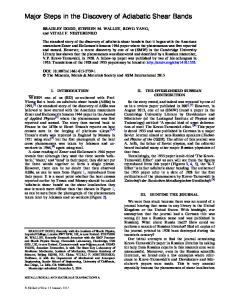Correlation of dynamic torsional properties with adiabatic shear banding behavior in ballistically impacted aluminum-lit
- PDF / 847,669 Bytes
- 9 Pages / 612 x 792 pts (letter) Page_size
- 106 Downloads / 299 Views
I.
INTRODUCTION
THE Al-Li alloys have high strengths and high stiffness as well as light weight,[1,2,3] thereby providing great potential to be used as structural armor materials. However, only limited information is available on the dynamic properties of Al-Li alloys, although the ballistic performance is known to correlate with dynamic deformation behavior, including the formation of adiabatic shear bands.[4–9] The adiabatic shear band is a narrow region of highly localized plastic deformation and is often observed when materials are deformed at high strain rates such as ballistic impact, machining, and high speed metal forming.[4,7–11] This is believed to initiate due to the development of a thermomechanical plastic instability. Since localization generally induces failure of structural components through a loss in load-carrying capacity within the shear band,[8,9,10] the adiabatic shear banding is of great interest to the ballistic performance of armors. The purpose of the present study is to correlate the adiabatic shear banding developed in Al-Li alloys upon ballistic impact with dynamic deformation behavior investigated from a dynamic torsional test, and then with the ballistic performance in order to obtain better understanding of the origin of the adiabatic shear banding in AlLi alloys. The materials investigated were a 2090 Al-Li alloy and a WELDALITE 049 alloy. The purpose of using *WELDALITE is a trademark of Martin Marietta Corporation, Baltimore, MD.
CHANG GIL LEE, Senior Researcher, is with the Materials Engineering Department, Korea Institute of Machinery and Materials, Changwon, 641-010 Korea. SUNGHAK LEE, Professor, is with the Center for Advanced Aerospace Materials, Pohang University of Science and Technology, Pohang, 790-784, Korea. Manuscript submitted March 10, 1997. METALLURGICAL AND MATERIALS TRANSACTIONS A
these Al-Li alloys was to allow a comparative study of different strengths and microstructures. The amount and the distribution of the adiabatic shear bands were compared with a 7039 Al alloy, which has been used as an armor material. The dynamic torsional experiment makes use of a torsional Kolsky bar (torsional split-Hopkinson bar) to deform thin-walled tubular specimens. The dynamic strain rate imposed in these tests was about 103 s21 in shear, and dynamic shear stress–shear strain curves were obtained from dynamic torsional test. Throughout these investigations, the role of microstructures such as grain boundaries, precipitates, and inclusions was considered as one of the important factors in the formation of the shear band. II.
EXPERIMENTAL
The materials investigated were a 2090 Al-Li alloy, a WELDALITE 049 alloy, and a 7039 Al alloy, and their chemical compositions are given in Table I. The 2090 alloy was prepared by the ingot metallurgy process, and then was rolled to a 10-mm-thick plate. The WELDALITE alloy and the 7039 Al alloy were obtained from Reynolds Metals Company (Richmond, VA) and Kaiser Aluminum International (Lafayette, LA), respectively, in the form of 10mm-thic
Data Loading...











